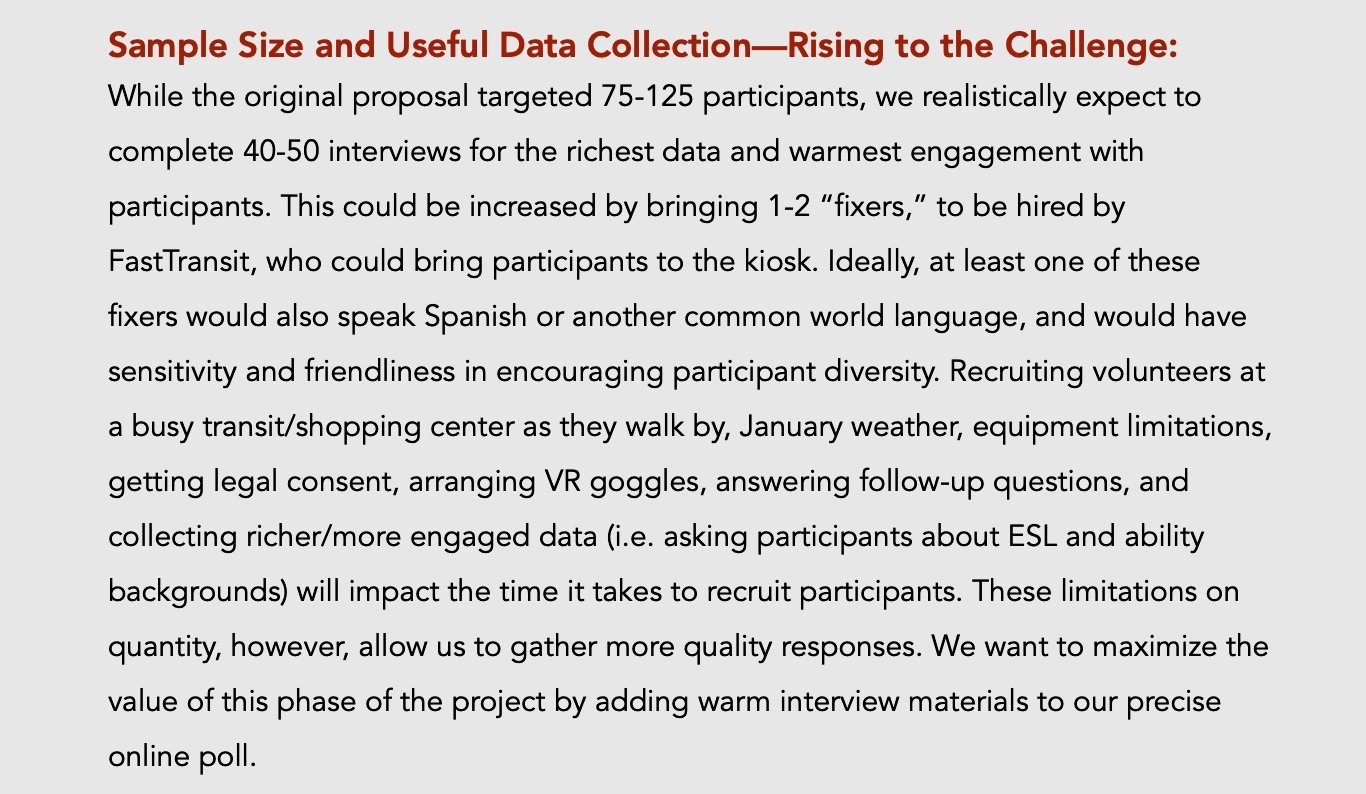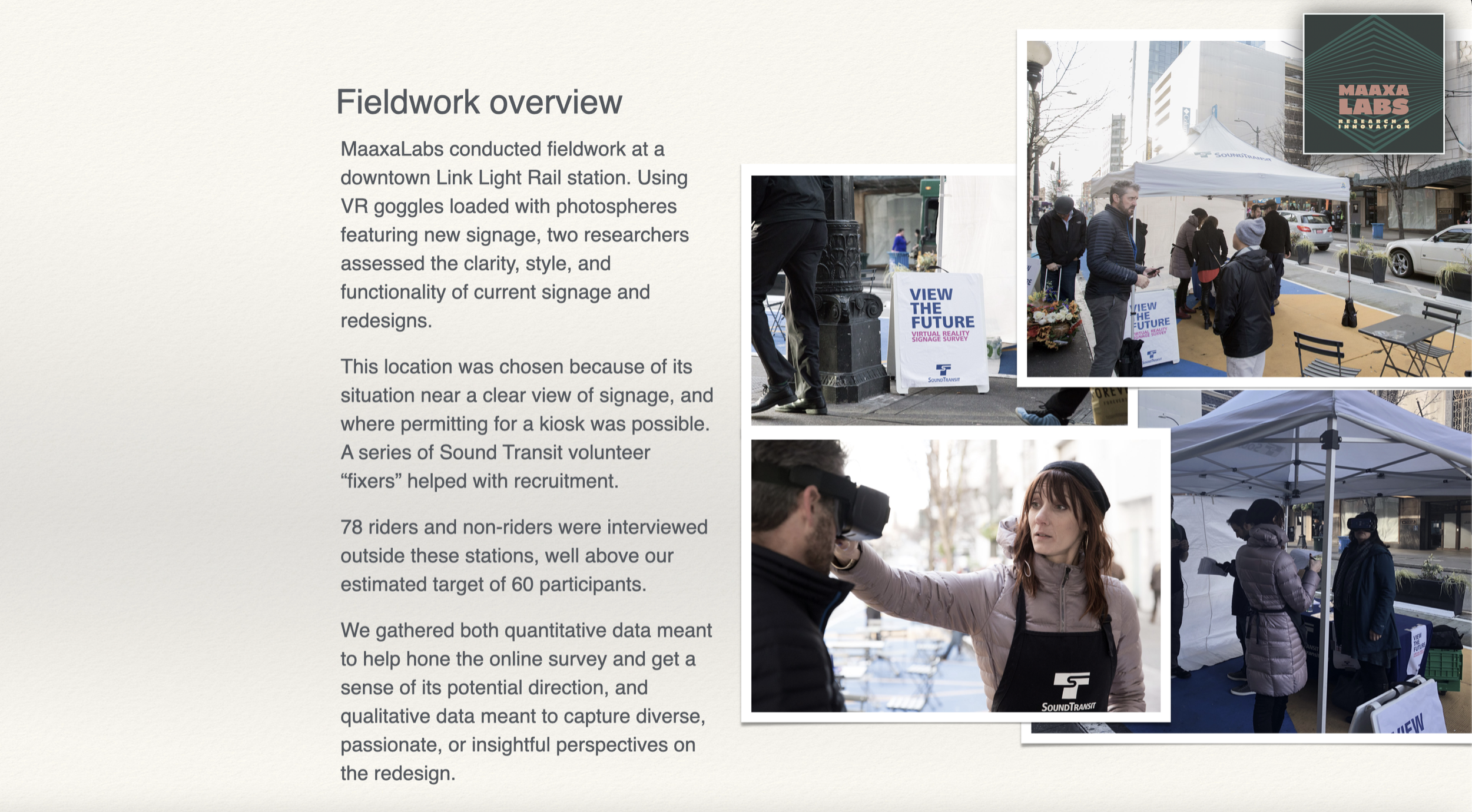Making Better Signs for Commuters with Seattle SoundTransit
MaaxaLabs used a comprehensive mixed methods process - a big survey to fieldwork with VR googles and back to a targeted survey - to help Seattle SoundTransit redesign impactful signage for customers with disabilities, non-English speakers, elders and more.
“We need new signs that do more than look good: they need to help more commuters and visitors from different walks of life find the right path to the right door to the right train.”
THE SITUATION:
My clients at Seattle SoundTransit had a rare, multi-million-dollar opportunity to better serve the public with their wayfinding signage. With big public grants and funding at stake, their redesign needed to bring a measurably better experience for train riders from all walks of life: daily commuters, tourists, long-range travelers, non-english speakers, elders needing better visibility, and people with disabilities needing reliable wayfinding.
I always love the opportunity to work in service design for public projects, where every insight I turn up from my research becomes synthesized into recommendations that can have big impact on people’s lives. I teamed up with public-facing design firm FCV to deliver improved signage. The result? Illuminated, clear, easy-to-understand signs that get millions of train riders where they need to go faster, without extra steps and unnecessary confusion.
THE TASK:
SoundTransit wanted to improve their signage along three dimensions. They conducted a preliminary survey, but couldn’t get data they felt comfortable making a multi-million-dollar decision on. They called us in to get the heart of rider needs. Here’s why:
Misleading survey data on how the signage options look:
Survey participants voted overwhelmingly for a “classic” look for the new signs. SoundTransit realized that they were getting a lot of votes from train enthusiasts (or railfans), who are committed to a vintage look for the train system. The survey wasn’t designed to block multiple votes from the same IP address, so many duplicate votes were found. MaaxaLabs needed to find a way to get around these barriers to find representative data from the full pool of users.
Misleading survey data on how visible the signage options are:
Visibility can mean a lot of different things to different people, so it can be difficult to gauge what a general category “visibility” means, especially in terms of the grants given to increase accessibility for Seattle area train riders. This question matters most to those with failing eyesight (i.e.: elders), to those whose mobility cannot take many extra steps to get a clearer view on wayfinding, and others for whom “visibility” may mean readability form a distance, or contrast, or clarity, Again, some on-the-ground work between researchers and riders could solve this lack of clarity and hone better survey questions.
Misleading survey data on how the signage options relay information:
This question is highly subjective - it can mean one thing to commuters trying to get to a train they know well, as quickly as possible. To others, information on what the connecting trains, train direction, and elevators is crucial. In order to sort out which options matter most to the populations for whom SoundTransit had received their grant was crucial.
We needed to design a research strategy that would uncover these various walks of life for train riders with different abilities, purposes, backgrounds, and demographics. I designed a project that would gather this information, try out a series of new signage options that these riders could view on the street using VR goggles, synthesize more direct signage options and survey questions, and execute a survey that would represent thew broader public, their needs, and democratize train accessibility.
This is how MaaxaLabs articulated the problem:
From my research proposal: coming up with a careful framework for measuring sentiment, demographics, and needs. Only then could SoundTransit be assured that they were staking their multi-million-dollar initiative on excellent data.
Is this project sparking ideas? Want to talk it over or kick around ideas for research with your customers? Schedule a free consult with Ali Maaxa!
THE ACTION:
First, we needed to understand the experience of diverse train riders so that we could ask the right questions of the right riders for the MaaxaLabs version of the signage survey. And we needed to more carefully shape the sign redesign options along a few different lines so we could measure what changes would impact whom, the most. I designed an onsite research study and worked with 80 train riders to understand their needs, frustrations, demographics, and attitudes. From these, we would form hypothesis that we would then test with thousands of riders via a survey.
A challenging, but very fruitful, onsite research design!
We were cold and rainy, and discovered so much about customer needs!
We synthesized our data and used it to shape a careful survey that would give SoundTransit precise direction that they could use to show stakeholders why they were making the decisions they were, and assure their success in assigning the grant funds to the right signs.
We then took the major themes we had collected during our VR googles study at the station, and designed a third, hybrid option for riders to choose from. I created a five-minute video with quotes and observations from real users who had tried the VR goggles too show why this option was so important, and backed that up with rigorous survey data.
THE RESULT:
In discovering the need for a hybrid version of the three proposed new sign designs, understanding why certain priority groups riders were choosing those traits, and evidencing the success of the hybrid design option, our clients were able to move forward with what has been celebrated as a successful, inclusive, and publicly supported signage redesign. And I got to meet some really amazing people on the streets of Seattle, and in the offices of SoundTransit.






